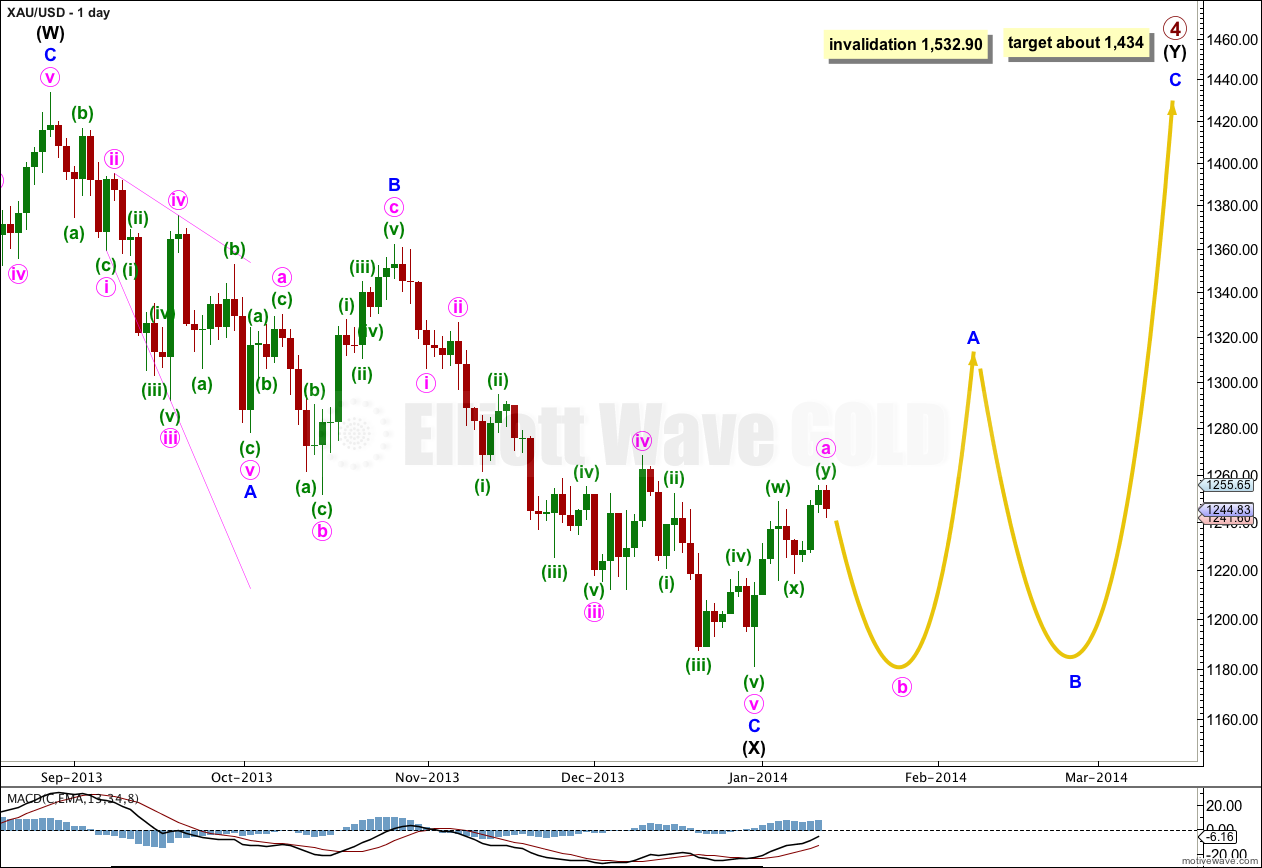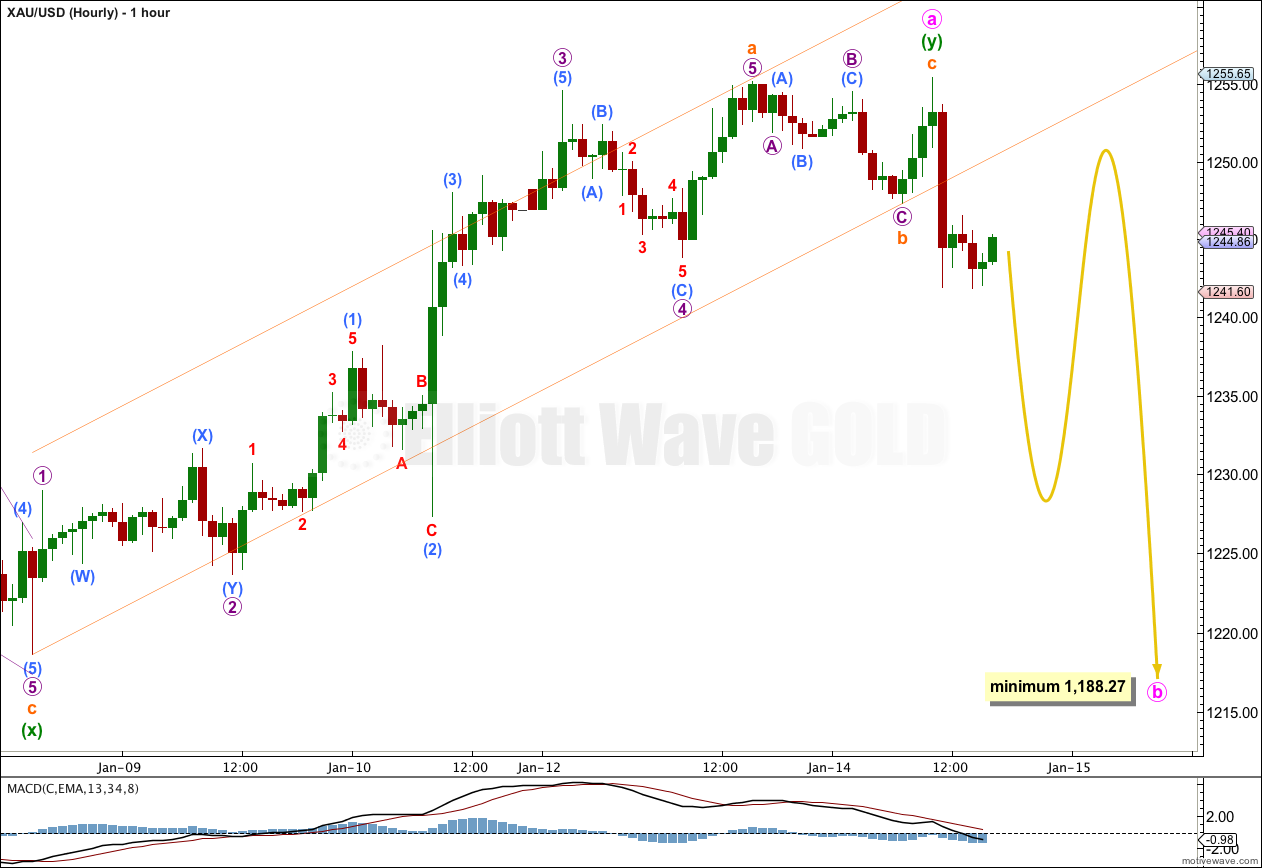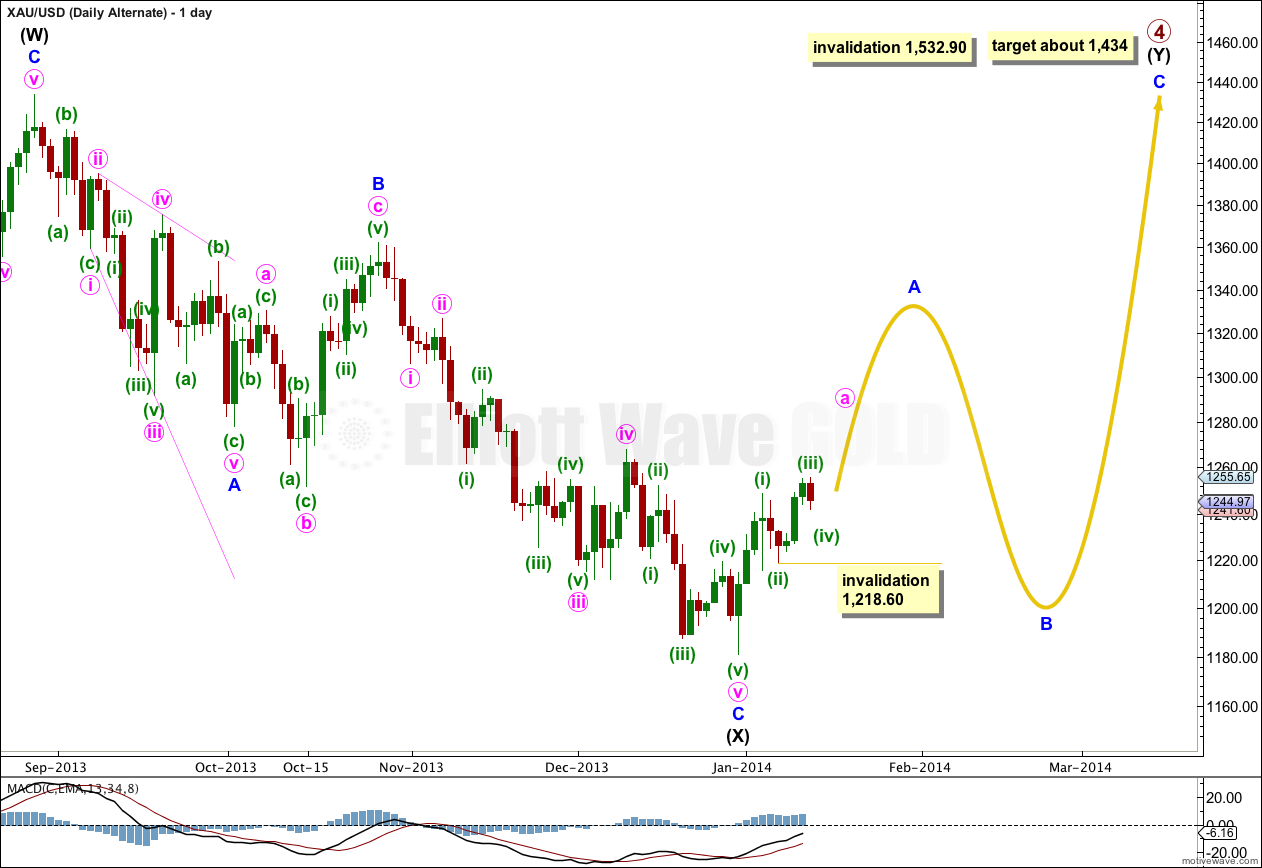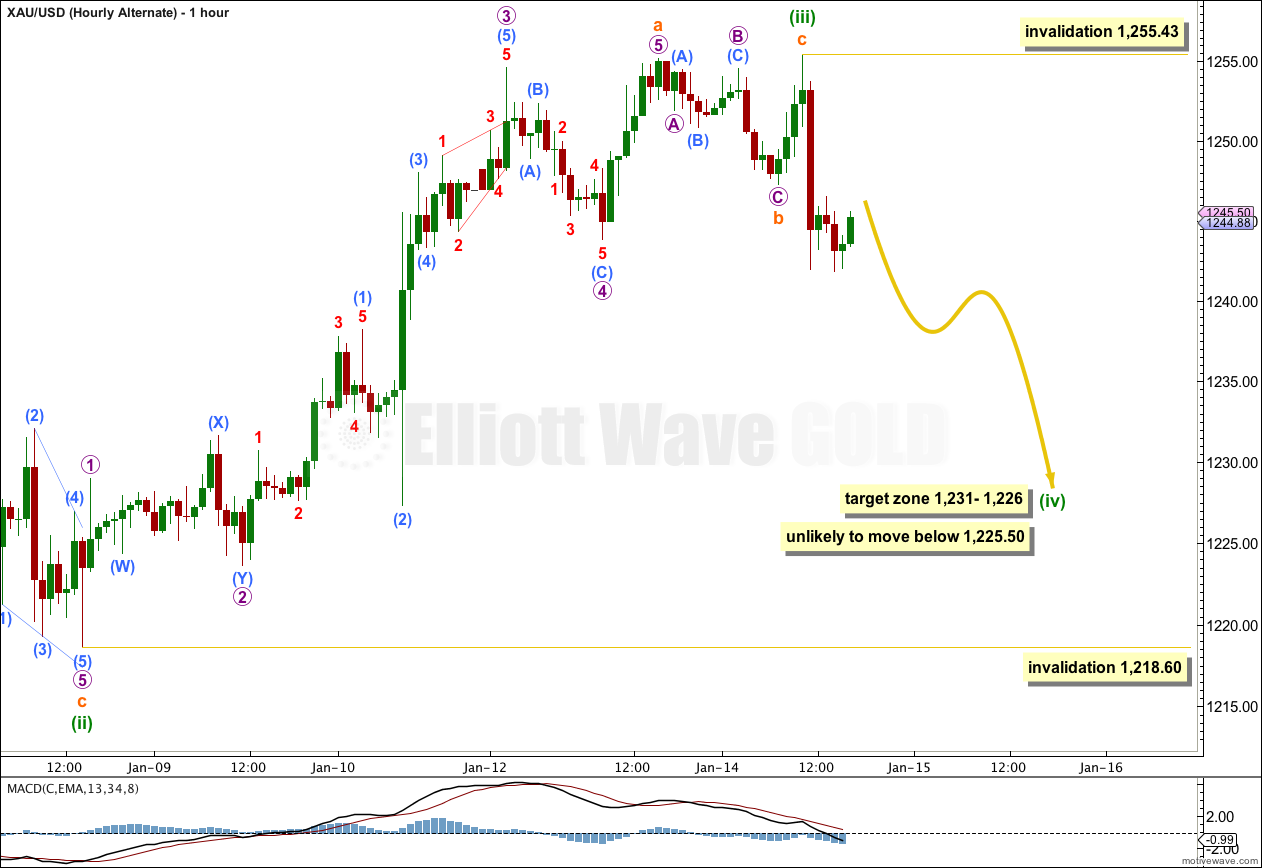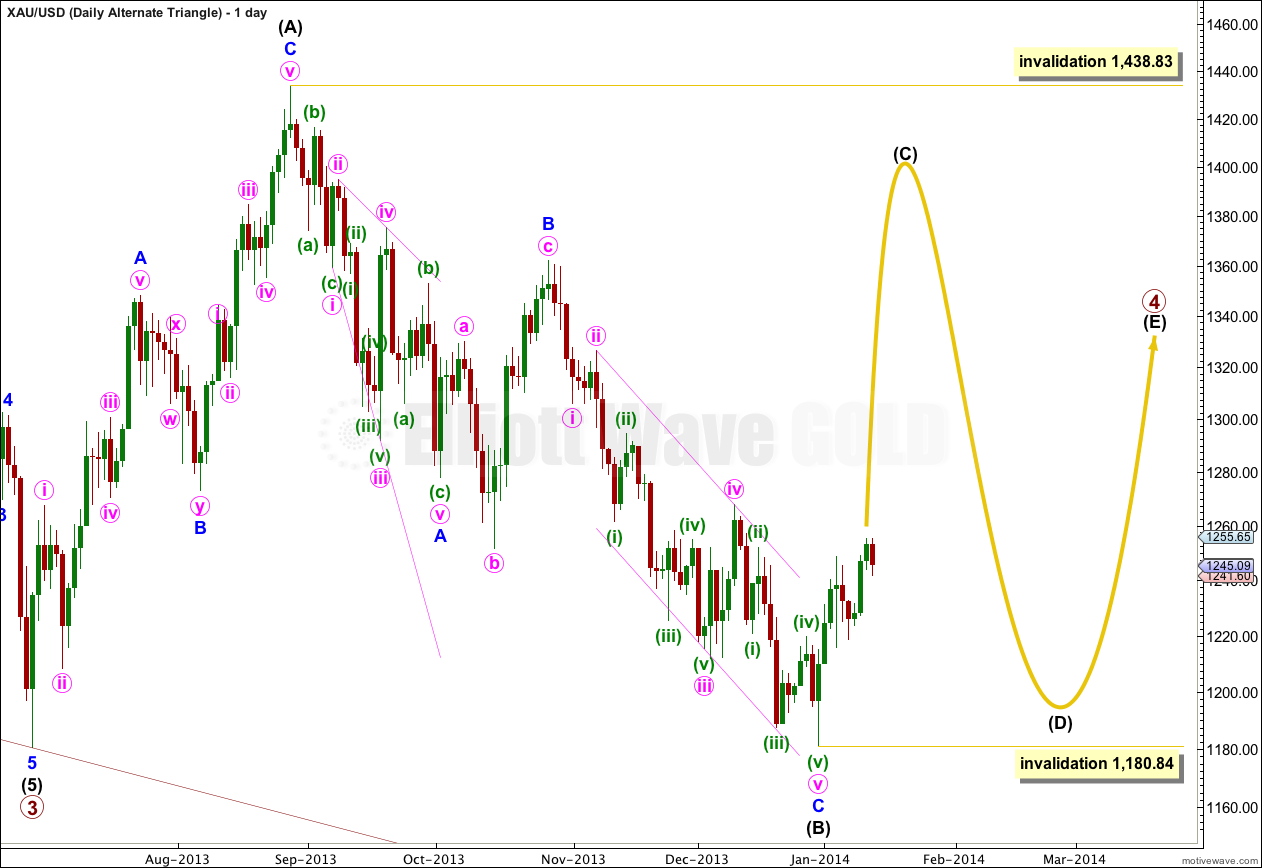Last analysis expected one or two more days of upwards movement towards a target at 1,280. This is not what happened. Downwards movement has breached the parallel channel on the hourly chart, and invalidated the main wave count at the hourly chart level.
The wave count at the daily chart level remains the same. I have a new alternate wave count for you today.
Click on the charts below to enlarge.
Gold is still within a large fourth wave correction at primary wave degree which is incomplete. To see a full explanation of my reasoning for expecting that primary wave 4 is not over and is continuing see this.
Movement above 1,277.97 would provide confirmation that primary wave 4 is not over. At that stage upwards movement could not be a fourth wave correction within primary wave 5 because it would be in its first wave price territory, and the downwards movement labeled intermediate wave (X) would be confirmed as a completed three wave structure.
When the channel about intermediate wave (X) is finally breached by upwards movement then I would consider that final confirmation that intermediate wave (Y) is underway.
Primary wave 2 was a rare running flat correction, and was a deep 68% correction of primary wave 1. In order to show alternation in structure primary wave 4 may be a zigzag, double zigzag, combination, triangle or even an expanded or regular flat. We can rule out a zigzag because the first wave subdivides as a three. This still leaves several structural possibilities.
The downwards wave labeled intermediate wave (X) is now 99% the length of the upwards wave labeled intermediate wave (W). Primary wave 4 is most likely to be a combination or triangle in order to show structural alternation with the running flat of primary wave 2.
Primary wave 4 is unlikely to be a flat correction because if it were it would be a regular flat. These have similar behaviour and a similar look to running flats, and so there would be little structural alternation between primary waves 2 and 4.
Primary wave 4 is most likely to be a combination rather than a double zigzag because of the depth of intermediate wave (X). Double combinations take up time and move price sideways, and their X waves can be very deep. Double zigzags are different because their purpose is to deepen a correction when the first zigzag does not move price deep enough, so their X waves are not normally very deep. Thus intermediate wave (Y) is most likely to be a flat correction, and less likely a triangle and least likely a zigzag. It is most likely to end about the same level as intermediate wave (W) at 1,434 so that the whole structure moves sideways. It may last about 43 to 89 days, depending upon what structure it takes.
If intermediate wave (Y) is a flat correction then within it minor wave B must retrace a minimum of 90% the length of minor wave A, and it may make a new low below 1,180.84.
If intermediate wave (Y) is a flat correction then within it minor wave A must subdivide as a three wave structure. At this stage it looks like minor wave A may be unfolding as a flat correction, because within it minute wave a looks like it is unfolding as a corrective structure (a double zigzag).
Primary wave 4 may not move into primary wave 1 price territory. This wave count is invalidated with movement above 1,532.90.
Movement below 1,243.82 invalidated the wave count as it was labeled yesterday. Prior to this invalidation there was a very clear breach of the parallel channel containing minuette wave (y) which was an indication that the zigzag was over and the next wave was underway.
Because downwards movement shows as a red candlestick on the daily chart I do not think this is subminuette wave b within minute wave (y). The zigzag of minuette wave (w) does not show its B wave on the daily chart, and so I would not expect this second zigzag in the double of minuette wave (y) to show its B wave on the daily chart. It looks most likely that minuette wave (y) is over.
Double zigzags are reasonably common structures, but triple zigzags are very rare indeed. Thus now that the second zigzag is over the probability that minute wave a is complete is very high.
When an A wave subdivides as a “three”, or corrective structure, then the correction is likely to be a flat. This requires minute wave b to reach a minimum depth of 90% the length of minute wave a at 1,188.27.
Minute wave b should last at least three days, and may last as long as 13 days. The duration will depend upon what structure unfolds. Minute wave b may be any one of 13 possible corrective structures (23 if every different type of combination is counted as a different structure). At this early stage it is impossible to tell which structure will unfold.
If minute wave b unfolds as a flat, running triangle or combination then within it we may see a new high above 1,255.43. There can be no upper invalidation point.
Overall I will be expecting very choppy overlapping movement trending lower, which should reach a minimum of 1,188.27 and would most likely last eight or thirteen days.
Alternate Wave Count.
The small length of the upwards movement from the low at 1,180.84 makes me consider the possibility that minute wave a may not be over.
If minor wave A subdivides as a three then there are still several possible corrective structures it may take. The most common structure for an A wave within a flat correction is a zigzag. Within the zigzag minute wave a may be either an impulse or a leading diagonal, with a leading diagonal less common than an impulse.
This alternate wave count looks at the possibility that minute wave a is unfolding as a leading contracting diagonal.
Within a leading diagonal subwaves two and four must subdivide as single zigzags. Subwaves one, three and five are most commonly zigzags but may also be impulses. With the first two upwards actionary waves subdividing as zigzags a leading diagonal should be considered.
Within a diagonal the fourth wave should overlap back into the first wave price territory, and so far this has happened. Within the diagonal minuette wave (iv) can only subdivide as a single zigzag. It may not move beyond the end of minuette wave (ii). This wave count is invalidated with movement below 1,218.60.
The depth of downwards movement will decide which wave count is correct.
Minuette wave (iii) is shorter than minuette wave (i) so the diagonal would be contracting. Minuette wave (iv) should not be longer than minuette wave (ii). Minuette wave (iv) would reach equality in length with minuette wave (ii) at 1,225.50. It should not move below this point.
Within the diagonal the common depth of minuette wave (iv) would be between 0.66 to 0.81 the length of minuette wave (iii), which is between 1,231 and 1,226.
Minuette wave (iv) must subdivide as a single zigzag. Within the zigzag its B wave may not move beyond the start of its A wave. This wave count is invalidated with movement above 1,255.43.
Alternate Daily Wave Count – Triangle.
It is also possible that primary wave 4 may continue as a regular contracting (or barrier) triangle.
The expected direction of this next upwards wave is the same, but for this alternate intermediate wave (C) of the triangle may not move beyond the end of intermediate wave (A). The triangle is invalidated with movement above 1,438.83.
Intermediate wave (C) must unfold as either a single or double zigzag. Within it no second wave correction, nor wave B of the zigzag, may move beyond the start of the first wave or A wave. This wave count is invalidated with movement below 1,180.84.
The final intermediate wave (E) upwards may not move above the end of intermediate wave (C) for both a contracting and barrier triangle. E waves most commonly end short of the A-C trend line.
All five subwaves of a triangle must divide into corrective structures. If this next upwards movement subdivides as a zigzag which does not make a new high above 1,438.83 then this alternate would be correct.
Triangles take up time and move price sideways. If primary wave 4 unfolds as a triangle then I would expect it to last months rather than weeks.

